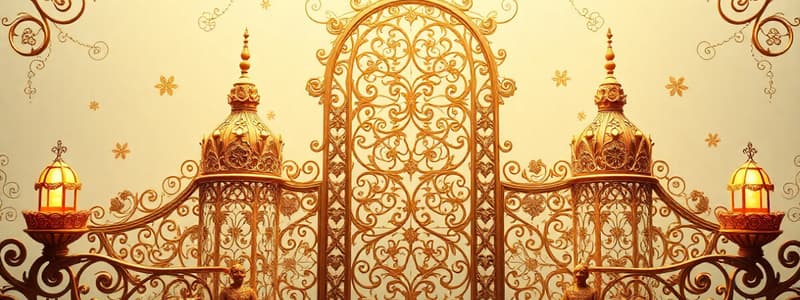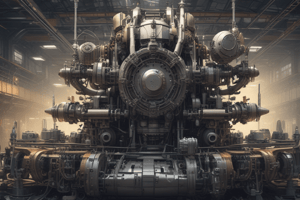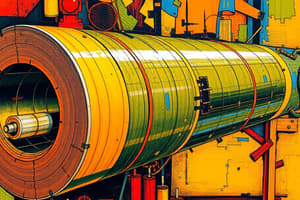Podcast
Questions and Answers
How does the billet temperature impact the extrusion force?
How does the billet temperature impact the extrusion force?
- Higher temperature leads to increased extrusion force.
- Higher temperature increases deformation resistance.
- As temperature increases, deformation resistance decreases. (correct)
- Higher temperature has no effect on extrusion force.
What is the primary role of a stripper plate in impact extrusion?
What is the primary role of a stripper plate in impact extrusion?
- To increase the flow of lubricants into the die.
- To cool the extruded parts rapidly after extrusion.
- To remove the extruded parts from the punch during the process. (correct)
- To change the angle of the die for better efficiency.
What effect does increasing the die angle have on lubricant flow during the extrusion process?
What effect does increasing the die angle have on lubricant flow during the extrusion process?
- It restricts lubricant flow into the die. (correct)
- It eliminates the need for lubricant altogether.
- It enhances lubricant flow into the die.
- It has no impact on lubricant flow.
Why would glass not be a suitable lubricant for impression-die forging?
Why would glass not be a suitable lubricant for impression-die forging?
What happens to extrusion force as the extrusion speed increases?
What happens to extrusion force as the extrusion speed increases?
What primarily determines the size and shape of the dead metal zone in square die extrusion?
What primarily determines the size and shape of the dead metal zone in square die extrusion?
Why is aluminum commonly used for extruded parts?
Why is aluminum commonly used for extruded parts?
What is the primary disadvantage of hot extrusion compared to cold extrusion?
What is the primary disadvantage of hot extrusion compared to cold extrusion?
What purpose does the glass serve in steel extrusions?
What purpose does the glass serve in steel extrusions?
In the welding-chamber process, what limitation is faced regarding lubrication?
In the welding-chamber process, what limitation is faced regarding lubrication?
What is a common characteristic of parts produced through cold extrusion?
What is a common characteristic of parts produced through cold extrusion?
Which process is primarily utilized for producing collapsible metal containers like toothpaste tubes?
Which process is primarily utilized for producing collapsible metal containers like toothpaste tubes?
In drawing processes, what limits the amount of area reduction achievable?
In drawing processes, what limits the amount of area reduction achievable?
What is the primary purpose of drawing in manufacturing?
What is the primary purpose of drawing in manufacturing?
Which of the following drawing processes primarily uses elevated temperatures?
Which of the following drawing processes primarily uses elevated temperatures?
What is the primary characteristic of direct extrusion?
What is the primary characteristic of direct extrusion?
What equipment is used for cold-drawing operations?
What equipment is used for cold-drawing operations?
Which of the following is a limitation of indirect extrusion?
Which of the following is a limitation of indirect extrusion?
What does the extrusion ratio (R) describe?
What does the extrusion ratio (R) describe?
How is the drawing force primarily generated in a Draw Bench?
How is the drawing force primarily generated in a Draw Bench?
What limitation is inherent when using a Draw Bench for drawing operations?
What limitation is inherent when using a Draw Bench for drawing operations?
Which condition is NOT relevant to the extrusion force required during the extrusion process?
Which condition is NOT relevant to the extrusion force required during the extrusion process?
How does hydrostatic extrusion affect the properties of brittle metals?
How does hydrostatic extrusion affect the properties of brittle metals?
What material characteristic is particularly high in thin steel wire produced for springs?
What material characteristic is particularly high in thin steel wire produced for springs?
In lateral extrusion, how is the ram positioned?
In lateral extrusion, how is the ram positioned?
Which term describes the zone in the extrusion chamber where metal does not flow through the die?
Which term describes the zone in the extrusion chamber where metal does not flow through the die?
What is the effect of metal flow during the extrusion process?
What is the effect of metal flow during the extrusion process?
Which type of drawing machine can contain multiple sequential dies?
Which type of drawing machine can contain multiple sequential dies?
What does the term 'Shape Factor' (S) refer to in the context of extrusion?
What does the term 'Shape Factor' (S) refer to in the context of extrusion?
What is the primary difference between extrusion and drawing processes?
What is the primary difference between extrusion and drawing processes?
What is the role of a spider die in the extrusion process?
What is the role of a spider die in the extrusion process?
What characterizes a dead-metal zone in the extrusion process?
What characterizes a dead-metal zone in the extrusion process?
Why is glass used as a lubricant in hot extrusion?
Why is glass used as a lubricant in hot extrusion?
In direct extrusion, how is the billet processed in relation to the die?
In direct extrusion, how is the billet processed in relation to the die?
What is the function of the land in a drawing die?
What is the function of the land in a drawing die?
Which factors can affect the extrusion pressure during the process?
Which factors can affect the extrusion pressure during the process?
What distinguishes reverse extrusion from direct extrusion?
What distinguishes reverse extrusion from direct extrusion?
Flashcards
Direct Extrusion
Direct Extrusion
A conventional extrusion process where a billet is pushed through a die by a hydraulic ram.
Indirect Extrusion
Indirect Extrusion
A less common extrusion process where the ram pushes the billet from behind, reducing friction and forces.
Lateral Extrusion
Lateral Extrusion
An extrusion process where the ram pushes the billet horizontally through a die, with the ram in a vertical position.
Hydrostatic Extrusion
Hydrostatic Extrusion
Signup and view all the flashcards
Extrusion Ratio (R)
Extrusion Ratio (R)
Signup and view all the flashcards
Circumscribing Circle Diameter (CCD)
Circumscribing Circle Diameter (CCD)
Signup and view all the flashcards
Shape Factor (S)
Shape Factor (S)
Signup and view all the flashcards
Extrusion Force
Extrusion Force
Signup and view all the flashcards
Metal Flow in Extrusions
Metal Flow in Extrusions
Signup and view all the flashcards
Dead Metal Zone in Extrusion
Dead Metal Zone in Extrusion
Signup and view all the flashcards
Extrusion Alloys
Extrusion Alloys
Signup and view all the flashcards
Extrusion Length Limits
Extrusion Length Limits
Signup and view all the flashcards
Extrusion Straightening
Extrusion Straightening
Signup and view all the flashcards
Hot Extrusion
Hot Extrusion
Signup and view all the flashcards
Welding-Chamber Extrusion
Welding-Chamber Extrusion
Signup and view all the flashcards
Extrusion Lubrication
Extrusion Lubrication
Signup and view all the flashcards
Cold Extrusion
Cold Extrusion
Signup and view all the flashcards
Impact Extrusion
Impact Extrusion
Signup and view all the flashcards
Spider Die
Spider Die
Signup and view all the flashcards
Drawing
Drawing
Signup and view all the flashcards
Drawing Force
Drawing Force
Signup and view all the flashcards
Drawing
Drawing
Signup and view all the flashcards
Drawing machine(Draw Bench)
Drawing machine(Draw Bench)
Signup and view all the flashcards
Bull Block
Bull Block
Signup and view all the flashcards
Extrusion
Extrusion
Signup and view all the flashcards
Dead Metal Zone
Dead Metal Zone
Signup and view all the flashcards
Skull
Skull
Signup and view all the flashcards
Drawing of wire
Drawing of wire
Signup and view all the flashcards
Tube-Drawing Operations
Tube-Drawing Operations
Signup and view all the flashcards
Tube sinking
Tube sinking
Signup and view all the flashcards
Extrusion
Extrusion
Signup and view all the flashcards
Forging
Forging
Signup and view all the flashcards
Rolling
Rolling
Signup and view all the flashcards
Extrusion vs. Drawing
Extrusion vs. Drawing
Signup and view all the flashcards
Spider Die
Spider Die
Signup and view all the flashcards
Dead Metal Zone
Dead Metal Zone
Signup and view all the flashcards
Glass Lubricant (Extrusion)
Glass Lubricant (Extrusion)
Signup and view all the flashcards
Direct vs. Reverse Extrusion
Direct vs. Reverse Extrusion
Signup and view all the flashcards
Die Land
Die Land
Signup and view all the flashcards
Extrusion Factors Affecting Pressure
Extrusion Factors Affecting Pressure
Signup and view all the flashcards
Extrusion force and extrusion ratio
Extrusion force and extrusion ratio
Signup and view all the flashcards
Extrusion force and die geometry
Extrusion force and die geometry
Signup and view all the flashcards
Extrusion force and speed
Extrusion force and speed
Signup and view all the flashcards
Extrusion force and billet temperature
Extrusion force and billet temperature
Signup and view all the flashcards
Stripper plate in impact extrusion
Stripper plate in impact extrusion
Signup and view all the flashcards
Die angle and lubricant flow
Die angle and lubricant flow
Signup and view all the flashcards
Die angle and redundant work
Die angle and redundant work
Signup and view all the flashcards
Die angle and dead metal zone
Die angle and dead metal zone
Signup and view all the flashcards
Glass as lubricant in hot extrusion
Glass as lubricant in hot extrusion
Signup and view all the flashcards
Spur and helical gears by drawing/extrusion
Spur and helical gears by drawing/extrusion
Signup and view all the flashcards
Study Notes
Extrusion & Drawing Processes
-
Direct Extrusion (Forward Extrusion): A common process where a cylindrical billet is loaded, and then a powerful hydraulic ram forces it through a small die at high pressure. The die opening can be round or shaped.
-
Indirect Extrusion: The chamber and billet remain stationary, and the ram is driven back into the chamber against the billet. This reduces friction requiring less ram force.
-
Lateral Extrusion: The ram is vertical and drives the billet horizontally through a die. Less common than direct or reverse extrusion.
-
Hydrostatic Extrusion: Uses a billet smaller than the chamber ID. Hydraulic pressure squeezes the billet from all sides through the die. Improves ductility of some brittle metals.
-
Extrusion Ratio (R): A measure of reduction from billet size to extrusion size (typically 10 < R < 100). Billet must be larger than the circumscribing circle diameter (CCD) of the extrusion.
-
Shape Factor (S): Measures the complexity of an extruded shape.
-
Extrusion Force: Depends on material strength, temperature, extrusion ratio, friction between the billet/chamber and metal/die surfaces, and die angle.
Extrusion Force Formula
-
Fextrusion=Ao×k×ln(AoAf)F_{extrusion} = A_o \times k \times ln(\frac{A_o}{A_f})Fextrusion=Ao×k×ln(AfAo)
- AoA_oAo = original billet area
- AfA_fAf = area of the extruded shape
- kkk = extrusion constant (affected by die angle, friction, and strength)
Metal Flow in Extrusions
- The flow of metal during extrusion affects final properties & quality.
- Similar to incompressible fluid flow in pipes, but at high pressure.
- An elongated grain structure may result; recrystallization may occur (depending on temperature).
- Dead metal zones may form during extrusion through square dies.
Extrusion Practicalities
- Common alloys include aluminum, copper, magnesium, and steel.
- Aluminum is commonly used and has high maximum CCD.
- Steel is hard to extrude and requires lubrication (glass).
- Maximum extruded lengths are limited.
Extrusion Temperature Ranges
- Extrusion can be done hot or cold, but hot extrusion is more versatile with lower forces & less die wear.
- Temperature ranges vary for different metals and alloys.
Die Design for Shapes
- Dies with thin sections & no cavities are easier.
- Complex shapes with internal cavities require special dies and processes (like spider-dies).
Welding-Chamber Process
- Metal flows around the supports and is re-welded downstream.
- Suitable for aluminum and other materials.
Drawing
- Similar to extrusion, but metal is pulled through a die.
- Area reduction is limited by the strength of the drawing wire.
- The available drawing force is limited to the breaking strength of the wire already drawn.
- Used to make wire, springs, cables, etc.
Drawing Force
-
Formula for drawing force without friction: F=YavgAo ln(Ao/Af)
-
F=YavgAo(1+(1/2)ln(Ao/Af) + (α/3)) (with friction)
- AoA_oAo = original billet area
- AfA_fAf= area of the extruded shape
- YavgY_{avg}Yavg = average true stress in the die gap
- µµµ = the co-efficient of friction
- ααα = the die angle (in radians)
Draw Bench
- Used for a single die or multiple dies.
- Gripping mechanism is pulled by chains to provide drawing forces.
- Used for heavy sections & shapes.
- Lengths of drawn items are usually limited.
Cold Extrusion
-
Similar to cold forging, creating good grain flow patterns and toughness.
-
Increased strength from strain hardening.
Extrusion vs. Rolling vs. Forging
- All involve compression, but extrusion forces metal through a die, rolling reduces thickness, and forging shapes the object in a die.
Studying That Suits You
Use AI to generate personalized quizzes and flashcards to suit your learning preferences.





